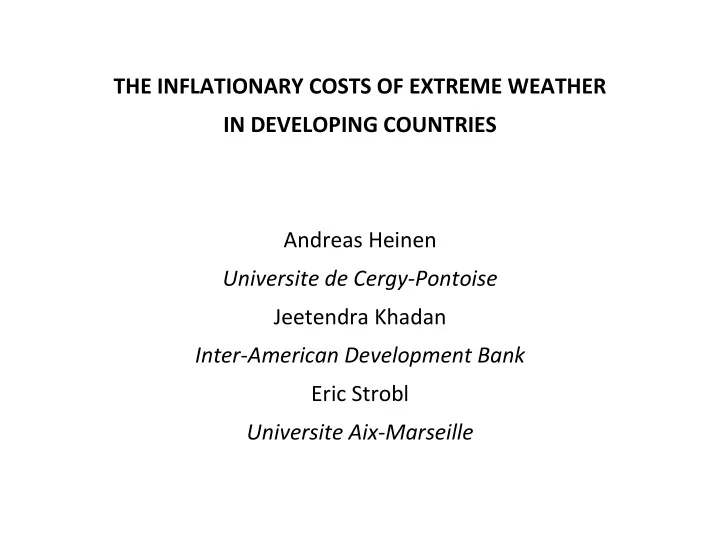

THE INFLATIONARY COSTS OF EXTREME WEATHER IN DEVELOPING COUNTRIES Andreas Heinen Universite de Cergy-Pontoise Jeetendra Khadan Inter-American Development Bank Eric Strobl Universite Aix-Marseille
INTRODUCTION Extreme weather → US$3 trillion of damages globally since 1980 Academic literature focused mostly on long-term impact However, driving factor is the short-term adjustment process Ex: shortages of goods and services → prices↑ Being able to predict prices will help policy makers choose the right fiscal & monetary policies in the aftermath
INTRODUCTION Previous literature: Cavallo & Cavallo (2014) examine 2010 Chile and 2011 Japan earthquakes → no price effect They argue this may be due to price stickiness (no price gauging) But: they estimate the effect on national prices of one large international supermarket
INTRODUCTION This paper: a. Estimates the impact of extreme weather on inflation in the Caribbean b. Calculates expected welfare effects using case study of Jamaica
INTRODUCTION
INTRODUCTION Arguably Caribbean is a good case study b/c: a. many hurricanes and floods per year (ex: Grenada 2004, St. Vincent & Grenadines 2013) b. small, non-diversified, import dependent economies c. potential costs of extreme weather estimated to be around 9 per cent of annual GDP by 2050
NATURAL DISASTER MODELING Hurricane
NATURAL DISASTER MODELING Excess Rainfall (Floods)
NATURAL DISASTER MODELING Modeling approach: a. Take physical characteristics of the event into account b. Model these at the ‘local’ level c. Take account of local exposure d. Assume a damage function
NATURAL DISASTER MODELING Hurricane Damage Function: j:island t:time (short-term) w : exposure weights at point i; W max : maximum wind at i W*: Threshold below which no damage Note: cubic function
DATA (hurricane tracks - HURDAT)
DATA (wind field model)
DATA (weights w ) Exposure: Nightlight Intensity – Jamaica (2012)
NATURAL DISASTER MODELING To identify floods we use an intensity duration model: Intensity: rainfall intensity Duration: rainfall duration α and β : estimated from Trinidad data on known flood events
NATURAL DISASTER MODELING Flood damage function: w : exposure weights at point i at time t-1 r : measure of rainfall r* : threshold above which rainfall becomes `excessive’
DATA (Rainfall - TRMM)
DATA Problem: Correlation between H and F during tropical storms
DATA Monthly price data: Nearly balanced panel for 15 island economies over the 2000- 2012 period for overall, food, housing, and other categories Avg Max Min St.dev. A total of 2,340 island-months of data Non-zero obs.: 142 for Hurricane and 683 for Floods
ECONOMETRIC ESTIMATION Specification: Estimation: Panel FE model with serially and cross-sectionally correlated errors, as well as year and month dummies Note: arguably H and F are exogenous
ECONOMETRIC RESULTS (1) (2) (3) INFL : ALL ALL ALL H t 1.311** 1.336** 1.325** (0.233) (0.244) (0.248) H t-1 1.058** 1.060** (0.264) (0.267) H t-2 0.0618 (0.253) F t 0.119* 0.123* 0.122* (0.0574) (0.0590) (0.0599) F t-1 0.0316 0.0295 (0.0672) (0.0686) F t-2 -0.0454 (0.0624) Avg. (max) economic impact: H: 1 st month - 0.08 (1.5); 2 nd month: 0.06 (1.2) F: 1 st month - 0.07 (0.514)
ECONOMETRIC RESULTS By commodity group: i. Hurricanes affected all categories, largest impact for Food ii. Floods only affected Food and Other Goods
EXPECTED WELFARE EFFECT To know potential welfare effects we need to measure: a. E ffect on welfare of ∆p’s changing due to extreme weather events b. Probabilities associated events To calculate welfare effect we use the concept of compensating variation:
EXPECTED WELFARE EFFECT Used Jamaica as a case study – Jamaica 2012 SLC (6,000 households) Jamaica: monthly CPI by good group (12) & region (3) Aggregated groups into food, housing, and other Used Δp’s and Δ’s to estimate price elasticities with an AIDS model
EXPECTED WELFARE EFFECT
EXPECTED WELFARE EFFECT
EXPECTED WELFARE EFFECT These estimates with the s ’s allow us to calculate out welfare loses due events To get ‘expected’ losses need to calculate out probabilities of events Two aspects: a. Hurricanes and Floods are extreme events b. They are not independent Used Bivariate POT models: (extreme value) Gumbel model → probability distribution of inflation effect (CV) of events But: infinite combinations of H and F …
EXPECTED WELFARE EFFECT Conditional (5 year Hurricane) Flood Events
EXPECTED WELFARE EFFECT Conditional (5 year Flood) Hurricane Events
CONCLUSION Extreme Weather Events can have significant, albeit short- lived effects on prices Depending on the ‘rarity’ of the events, these can then translate into substantial welfare losses Welfare losses larger for the rich due to their greater spending on housing related goods and the greater price elasticity of housing related goods
Recommend
More recommend